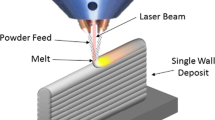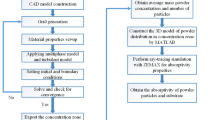Abstract
As a promising additive manufacturing method, direct energy deposition has been widely used to fabricate complex thin-walled parts. However, some defects such as uneven layer surface and excessive build-ups always occur in this process. In this study, a high-fidelity model adopting a novel laser/powder source is developed to simulate the detailed multi-layer deposition process. With layer surfaces being tracked in real-time, laser source model incorporates local incidence angle and defocusing amount to adjust absorbed energy and beam radius on the track surfaces. The powder catchment efficiency varies with the defocusing amount timely. The simulations demonstrate that build-ups are mainly induced by unstable linear powder feed rate and worsen due to laser/powder defocusing and accumulated heat. The layer surface unevenness results from powder positive defocusing, while molten pool dynamics, laser positive defocusing and accumulated heat plays a supplementary role. Eliminating methods are proposed based on the simulations and validated by experiments.










Similar content being viewed by others
References
Dwivedi R, Zekovic S, Kovacevic R (2007) A novel approach to fabricate uni-directional and branching slender structures using laser-based direct metal deposition. Int J Mach Tools Manuf 47(7–8):1246–1256
Dwivedi R, Kovacevic R (2006) An expert system for generation of machine inputs for laser-based multi-directional metal deposition. Int J Mach Tools Manuf 46(14):1811–1822
Mazumder J, Schifferer A, Choi J (1999) Direct materials deposition: designed macro and microstructure. Mater Res Innov 3(3):118–131
Pei YT, De Hosson JTM (2000) Functionally graded materials produced by laser cladding. Acta Mater 48(10):2617–2624
Bi G, Gasser A, Wissenbach K, Drenker A, Poprawe R (2006) Identification and qualification of temperature signal for monitoring and control in laser cladding. Opt Lasers Eng 44(12):1348–1359
De Oliveira U, Ocelik V, De Hosson JTM (2005) Analysis of coaxial laser cladding processing conditions. Surf Coat Technol 197(2–3):127–136
Wen S, Shin YC (2010) Modeling of transport phenomena during the coaxial laser direct deposition process. J Appl Phys 108(4):044908
El Cheikh H, Courant B, Branchu S, Hascoet J-Y, Guillen R (2012) Analysis and prediction of single laser tracks geometrical characteristics in coaxial laser cladding process. Opt Lasers Eng 50(3):413–422
Yan W, Ge W, Smith J, Lin S, Kafka OL, Lin F, Liu WK (2016) Multi-scale modeling of electron beam melting of functionally graded materials. Acta Mater 115(2016):403–412
Yan W, Ge W, Qian Y, Lin S, Zhou B, Liu WK, Lin F, Wagner GJ (2017) Multi-physics modeling of single/multiple-track defect mechanisms in electron beam selective melting. Acta Mater 134(2017):324–333
Bi G, Gasser A, Wissenbach K, Drenker A, Poprawe R (2006) Characterization of the process control for the direct laser metallic powder deposition. Surf Coat Technol 201(6):2676–2683
Hu D, Kovacevic R (2003) Sensing, modeling and control for laser-based additive manufacturing. Int J Mach Tools Manuf 43(1):51–60
Zhu G, Li D, Zhang A, Pi G, Tang Y (2012) The influence of laser and powder defocusing characteristics on the surface quality in laser direct metal deposition. Opt Laser Technol 44(2):349–356
Pant P, Chatterjee D, Nandi T, Samanta SK, Lohar AK, Changdar A (2019) Statistical modeling and optimization of clad characteristics in laser metal deposition of austenitic stainless steel. J Braz Soc Mech Sci Eng 41(7):283
Alimardani M, Toyserkani E, Huissoon JP (2007) Three-dimensional numerical approach for geometrical prediction of multilayer laser solid freeform fabrication process. J Laser Appl 19(1):14–25
Song B, Yu T, Jiang X, Xi W (2019) Numerical model of transient convection pattern and forming mechanism of molten pool in laser cladding. Numer Heat Transf Part A Appl 75(12):855–873
Wang S, Zhu L, Fuh JYH, Zhang H, Yan W (2020) Multi-physics modeling and gaussian process regression analysis of cladding track geometry for direct energy deposition. Opt Lasers Eng 127(2020):105950
Zhou J, Tsai H-L, Lehnhoff T (2006) Investigation of transport phenomena and defect formation in pulsed laser keyhole welding of zinc-coated steels. J Phys D Appl Phys 39(24):5338
Tseng W, Aoh J (2013) Simulation study on laser cladding on preplaced powder layer with a tailored laser heat source. Opt Laser Technol 48(2013):141–152
Hirt C, Nichols B (1988) Flow-3d user’s manual. Flow Science Inc, Santa Fe, p 107
Nugent S, Posch HA (2000) Liquid drops and surface tension with smoothed particle applied mechanics. Phys Rev E 62(4):4968–4975
Tartakovsky AM, Meakin P (2005) Modeling of surface tension and contact angles with smoothed particle hydrodynamics. Phys Rev E 72:026301
Tabernero I, Lamikiz A, Ukar E, De Lacalle LL, Angulo C, Urbikain G (2010) Numerical simulation and experimental validation of powder flux distribution in coaxial laser cladding. J Mater Process Technol 210(15):2125–2134
Wen S, Shin Y, Murthy J, Sojka P (2009) Modeling of coaxial powder flow for the laser direct deposition process. Int J Heat Mass Transf 52(25–26):5867–5877
Hirt CW, Nichols BD (1981) Volume of fluid (vof) method for the dynamics of free boundaries. J Comput Phys 39(1):201–225
Mills KC (2002) Recommended values of thermophysical properties for selected commercial alloys. Woodhead Publishing, Cambridge
Prabhakar P, Sames WJ, Dehoff R, Babu SS (2015) Computational modeling of residual stress formation during the electron beam melting process for inconel 718. Addit Manuf 7(2015):83–91
Li S, Xiao H, Liu K, Xiao W, Li Y, Han X, Mazumder J, Song L (2017) Melt-pool motion, temperature variation and dendritic morphology of inconel 718 during pulsed-and continuous-wave laser additive manufacturing: a comparative study. Mater Des 119(2017):351–360
Acknowledgements
This research is supported by the National Research Foundation, Prime Minister’s Office, Singapore under its Campus for Research Excellence and Technological Enterprise (CREATE) program. Shuhao Wang acknowledges the support by China Scholarship Council. Lida Zhu acknowledges the support by the National Natural Science Foundation of China (51975112).
Author information
Authors and Affiliations
Corresponding author
Additional information
Publisher's Note
Springer Nature remains neutral with regard to jurisdictional claims in published maps and institutional affiliations.
Rights and permissions
About this article
Cite this article
Wang, S., Zhu, L., Dun, Y. et al. Multi-physics modeling of direct energy deposition process of thin-walled structures: defect analysis. Comput Mech 67, 1229–1242 (2021). https://doi.org/10.1007/s00466-021-01992-9
Received:
Accepted:
Published:
Issue Date:
DOI: https://doi.org/10.1007/s00466-021-01992-9




